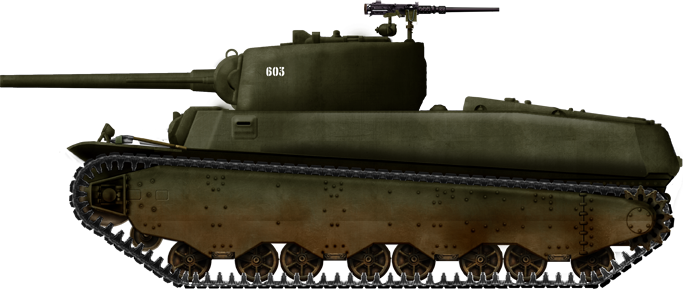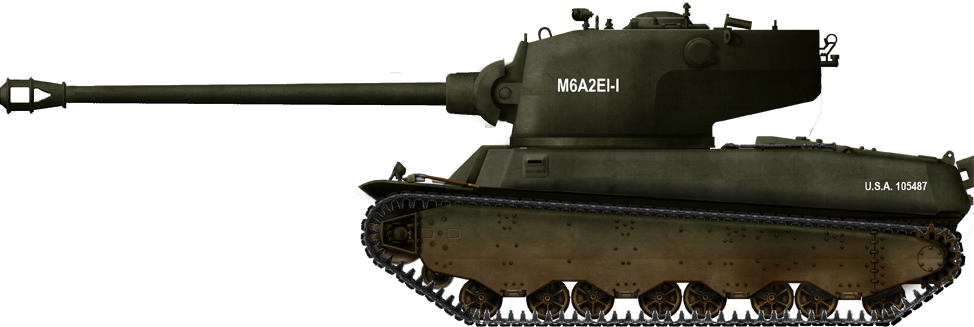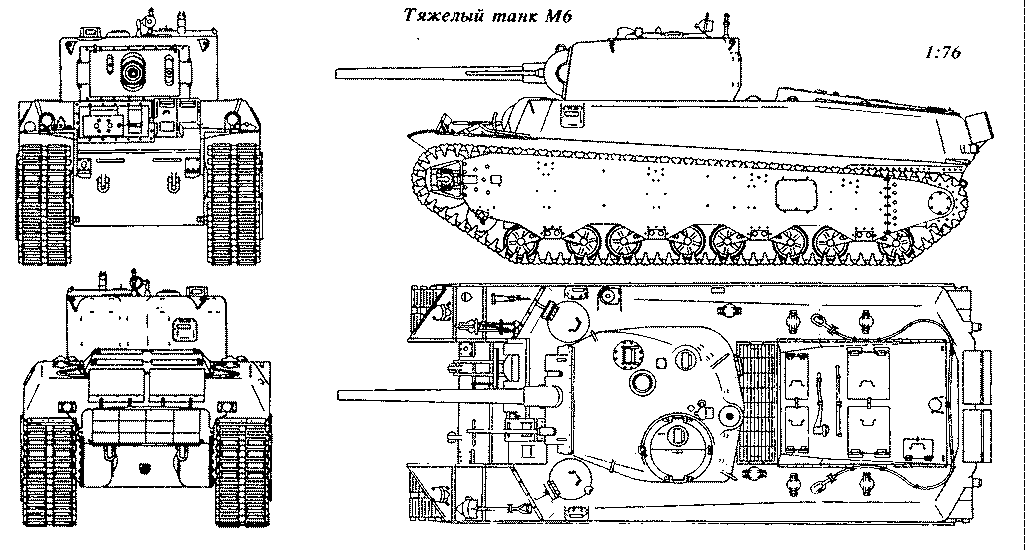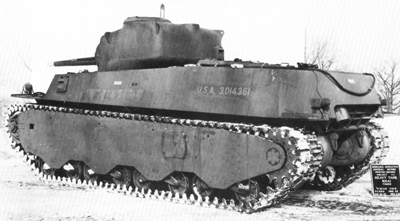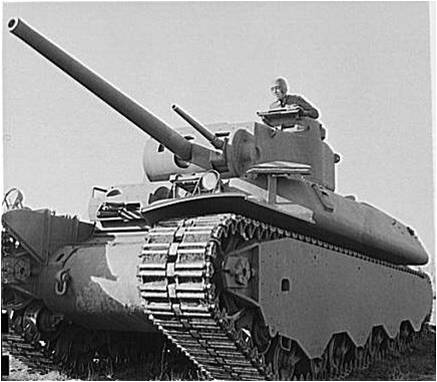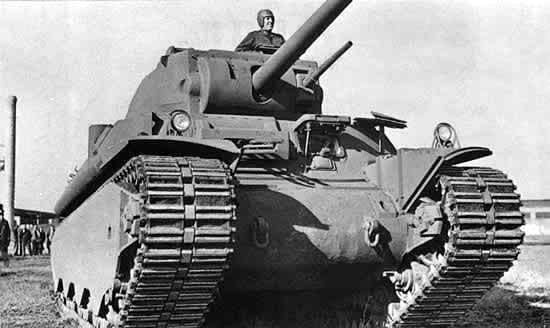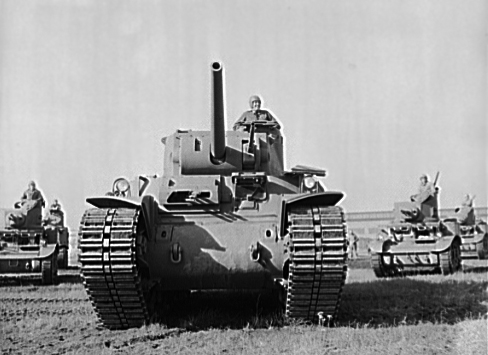The first US WW2 heavy tank
Little known, the M6 was the first modern US heavy tank. The only other heavy tank built in series was the Liberty or Mark VII, a joint US-British design, produced in 1918, of the WWI-era lozenge type. When the Second World War broke out, the successful German campaign of 1940 gave a spur to US tank development. Already, on 20 May 1940, the Chief of Infantry recommended to the US Army Ordnance Corps to study a 50-ton tank design. The first one was a projected multi-turreted model with a main 75 mm (2.95 in) turret, a secondary one with a 37 mm (1.46 in) gun and coaxial M1919A4, and another, smaller turret with a 20 mm (0.79 in) gun and coaxial cal.30 (7.62 mm), plus four cal.30 machine guns in each corner of the tank in ball mounts. In was approved on 11 June 1940 under the ordnance prototype registration T1 heavy tank. The T1 had to be fitted with a cast hull and hydramatic transmission. However, this design already appeared outdated. In October, this was changed for a more conventional approach, the T1E1.T1E1 and T1E2 prototypes (1942)
This second design had a single three-man turret, with a vertically-stabilized 3 in gun (75 mm) coupled with a coaxial 37 mm (1.46 in) gun. The turret was cast and had an electric drive and manual traverse. There was also a bow mount with twin cal.50 (12.7 mm) machine guns handled by the assistant driver. The commander cupola and some other parts were borrowed from the M3 Lee. The suspension was also borrowed from the M3, being a standard vertical volute spring (VVSS), with four bogies per side, but the tracks were doubled in width, with two rubber shoes instead of one. The upper tracks reposed on a guide rail, and the entire side was protected by large, one-piece side skirt. The armor ranged from 83 mm (3.27 in) to 44 mm (1.73 in), while the hull was sloped. The overall weight was a staggering 50+ tons. Due to this, the main issues were the engine and transmission.The Society of Automotive Engineers was charged with finding a suitable combination. The Wright G-200 air-cooled radial gasoline engine was initially selected, and served with an electric transmission, a hydramatic one or with a torque converter. Three prototypes were ordered, but only two were delivered early in 1942 by Baldwin Locomotive Works, using the electric transmission and torque converter. One differed by having a cast hull, while the other had a welded one. On 26 May 1942, other prototypes of both series were ordered under the T1E1 designation (unofficially M6A2), with electric transmission, welded hull, 20 being built, and T1E2 (M6), with the torque converter, with a cast hull, 8 built.
The M6 and M6A1
Eventually, after many unit trials, the Ordnance Corp advised to concentrate only on the torque converter variants, and a third improved series, the T1E3 (M6A1) was ordered. Recommendations included that 115 M6s would be built for US army service and 115 others for the Allies, starting in December 1942. These series vehicles were given a two-piece cupola hatch and ring mount for an AA cal.50 (12.7 mm). The left front machine-gun was removed. However, the Armored Corps had quickly grasped the utility of having a single tank type in service, cheaper and easier to transport, such as the Sherman, and the production was stopped. The development, however, did not end there.M6A1E2
In early 1944 the M6A1 was successfully tested with the new experimental T7 90 mm (3.54 in), but a new turret layout was urgently needed. In August 1944, the Ordnance Corps recommended an experimental series of 15 T1E1s with a new turret, later known as the M6A1E2. Main features were the new, tall and roomy turret, with a pronounced rear turret basket from the T29 heavy tank prototype, a new sloped hull, 7.5 in (190 mm) thick at the front and a T5E1 105 mm (4.13 in) gun, giving an overall weight of 77 tons. This project was rejected by General Eisenhower, but the development of heavy tanks was not terminated. Another project would eventually lead to the excellent M26 Pershing.Active service
Since the M6 was never approved for mass-production, the small series built remained on American soil, for training purposes, unit maneuver drills, and later propaganda movies, war bond tours and various related displays throughout the United States. On 14 December 1944, the M6 was declared obsolete and all but one of these scrapped, the latter now stored on display at the U.S. Army Ordnance Museum, at Aberdeen, Maryland.M6 heavy tank gallery

The M6A2E1, number one (15 built), testing the 105 mm (4.13 in) gun and new turret.
Link: The M6 on WWIIVehicles
M6A1 heavy tank specifications |
|
| Dimensions (L-w-H) | 8.43 x 3.12 x 2.38 m (27 ft 8 in x 10 ft 3 in x 7 ft 10 in) |
| Total weight, battle ready | 57.4 tons (126,500 lbs) |
| Crew | 6 (commander, driver, assistant driver, loader, gunner) |
| Propulsion | 1823 ci (29.88 liters) Wright G-200 9-cylinder gasoline, 825 hp at 2300 rpm |
| Maximum speed | 22 mph (35 km/h) on road |
| Suspensions | Vertical Volute Springs (VVSS) |
| Range | 160 km (100 mi) |
| Armament | Main: 75 mm (2.95 in) gun M7, 75 rounds Secondary: 2 cal.50 M2Hb (12.7 mm), 2 cal.30 (7.62 mm) Browning M1919A4 |
| Armor | Turret 83 mm (3.27 in), lower sides 70 mm (2.76 in), upper sides 44 mm (1.73 in) |
| Production (M6A1 alone) | 12 |

WW2 Tanks




























WW2 tanks posters

All Tiger tanks liveries.

Panther liveries and variants

WW2 Armour - All tanks











Tanks aces and single tanks series

Find more there

Museums, Movies, Books & Games
The Tanks and Armor in pop culture
Tanks and armored vehicles in general are only really grasped when seen first person: The mass, the scale, it's all there. Explore also the way tanks were covered in the movie industry, in books and in video games.Movies:
Best tanks movie on warhistoryonline.com
On imdb.com
On bestsimilar.com/
miltours.com
liveabout.com/
watchmojo.com
Video Games:
pcgamesn.com
historyhit.com
levvvel.com
vg247.com/best-tank-games
mmobomb.com/
alienwarearena.com

